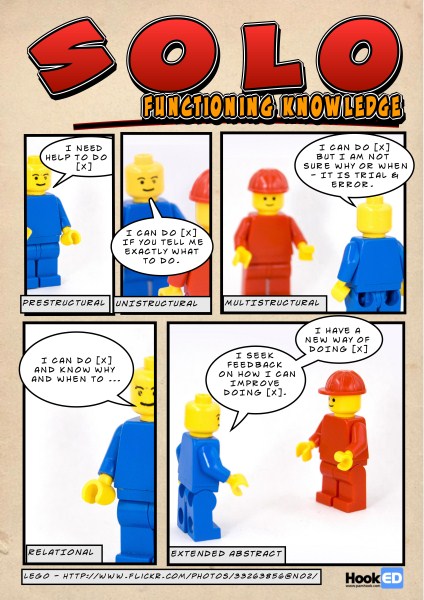Feed Back
This wiki page describes how SOLO Taxonomy can be adapted for use with students and teachers to improve the effectiveness of feedback (how am I going?). Other pages will explore “feed up” (where am I going?) and “feed forward” (what should I do next?).
Contents |
Overview
| Feed Up | Feed Back | Feed Forward |
|---|---|---|
| Where am I going? | How am I going? | Where to next? |
| Be explicit about the learning task and success criteria. Set appropriate, challenging and specific goals,Intended Learning Outcomes (ILO),Learning Intentions (LI). | Self assess progress against the success criteria. | Set next learning steps. |
|
We are learning to ... (WALT), I am learning to ... (IALT) |
I will know I am successful when ..., My learning outcome is ... because ... |
My next step is to .... |
|
Effort and effective strategies. |
Effort and effective strategies. |
Effort and effective strategies. |
Feedback follows instruction
Feed back is purposeful activity (undertaken by both teachers and students) designed to advise the achievement of an intended learning outcome (ILO).[1]
Feedback can be used to address declarative knowledge (knowing about things) and functioning knowledge (performance based on knowing about things) at the content level, process level, self-regulatory level and self level (Hattie, 2011, p177).
Feedback is at its most effective when it provides explicit, proximate and hierarchical prompts for achieving a desired learning goal.
- ‘explicit’ clarifies the meaning of the task needed to meet the ILO,
- ‘proximate’
- ‘hierarchical’ ensures the task provides challenge and advancement from existing understandings towards the ILO.
It seems plausible that when feedback fulfils these three criteria it gives agency to students by making the task seem achievable, and as a consequence the student may be more likely to increase effort (and/or use of effective strategies) to achieve the ILO.
The challenge for educators is always to find ways to improve their pedagogical content knowledge so as to make feedback between teachers and students (and between students and teachers) more effective: more explicit, proximal and/or hierarchical.
HookED SOLO Self-Assessment Rubrics
Student Rubrics
SOLO Blogging Rubrics | SOLO Dance Rubrics | SOLO Drama Rubrics | SOLO e-Competency Rubrics | SOLO Economics Rubrics | SOLO Fabric Technology Rubrics | SOLO Food Technology Rubrics | SOLO Geography Rubrics |SOLO Hard Materials Rubrics | SOLO Health Education Rubrics | SOLO History Rubrics | SOLO ICT Use Rubrics | SOLO Inquiry Rubrics | SOLO Key Competency Rubrics | SOLO Languages Rubrics | SOLO Literacy Rubrics | SOLO Maths Rubrics | SOLO Music Rubrics | SOLO NCEA Rubrics | SOLO Outdoor Education | SOLO Programming Rubrics | SOLO Physical Education Rubrics | SOLO Questioning Rubrics | SOLO Religious Education Rubrics | SOLO Science Rubrics | SOLO Social Sciences Rubrics | SOLO Te Reo Rubrics | SOLO Technology Rubrics | SOLO Values Rubrics | SOLO Visual Arts Rubrics | SOLO Web Page Validity Rubrics
Teacher Rubrics
SOLO Effective Pedagogy Rubrics | Registered Teacher Criteria Rubrics | E-Learning Rubrics | [[Reflective Question Rubrics] | [Pumawanatanga Rubrics - The Educultural Wheel ]
Principal Rubrics
SOLO Primary Principal Rubrics
Functioning Knowledge Rubric
Declarative Knowledge Rubric
[1] New Zealand schools variously use Intended Learning Outcome (ILO) or Learning Intention (LI) to describe an identified learning goal.

